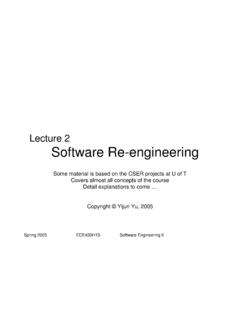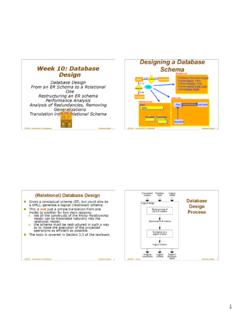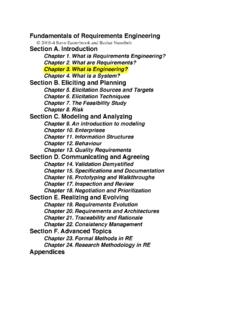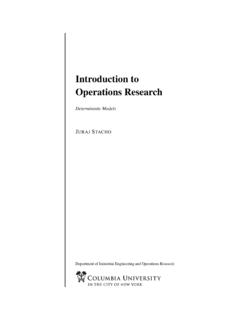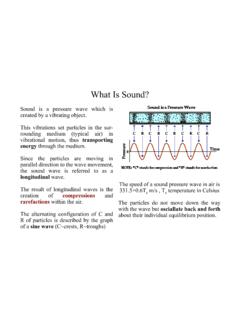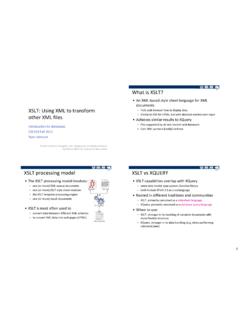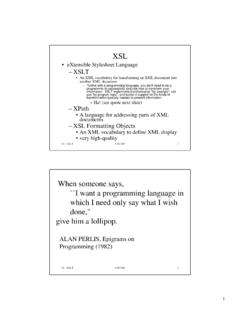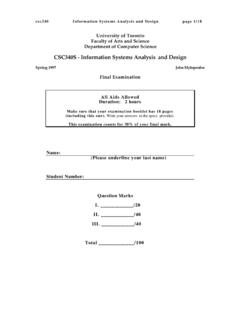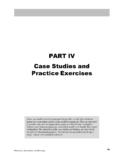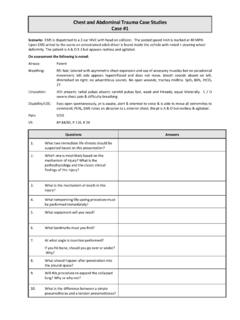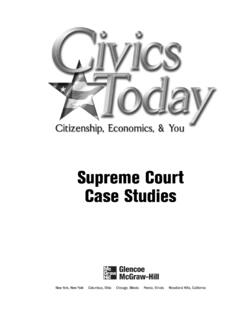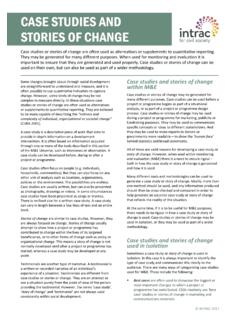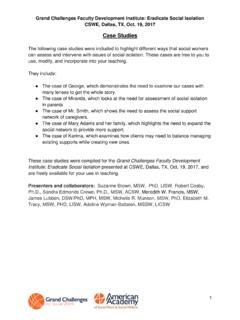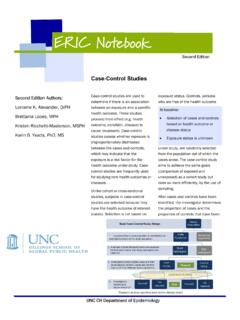Transcription of Tutorial F2 Case Studies for Software Engineers
1 128th International Conference on Software Engineering 2006 Easterbrook, Sim, Perry, ArandaTutorial F2 case Studies for Software EngineersSteve Easterbrook University of TorontoJorge Aranda University of TorontoThis Tutorial was originally developed with:Susan Elliott Sim University of California, IrvineDewayne E. Perry The University of Texas at AustinTutorial F2 case Studies for Software Engineers 2006 Easterbrook, Sim, Perry, Aranda2 Goals of this Tutorial For researchers: differentiate case Studies from other empirical methods a solid grounding in the fundamentals of case Studies as a research method understand and avoid common mistakes with case Studies For reviewers: guidance to judge quality and validity of reported case Studies .
2 Criteria to assess whether research papers based on case Studies aresuitable for publication For practitioners: awareness of how to interpret the claims made by researchers about newsoftware engineering methods and tools. insights into the roles practitioners can play in case Studies research2 Tutorial F2 case Studies for Software Engineers 2006 Easterbrook, Sim, Perry, Aranda3 Overview Session 1:Recognising case Studies 9:00-9:30 Empirical Methods in SE 9:30-9:45 Basic Elements of a casestudy9:45-10:30 Exercise: Read andDiscuss Published case studies10:30-11:00 Coffee break Session 2:Designing case Studies I 11:00-11:30 Theory Building11:30-11:45 Exercise: Identifyingtheories in SE 11:45-12:30 Planning and DataCollection12:30-2:00 Lunch Session 3:Designing case Studies II2:00-2:30 Exercise: Design a CaseStudy 2:30-3:30 Data Analysis and Validity3:30-4:00 Tea break Session 4.
3 Publishing and Reviewing CaseStudies4:00-4:30 Exercise: Design a CaseStudy (concludes) 4:30-5:00 Publishing case Studies 5:00-5:15 Reviewing case Studies 5:15-5:30 Summary/Discussion5:30 Finish28th International Conference on Software Engineering 2006 Easterbrook, Sim, Perry, Aranda1. Empirical Methods in SoftwareEngineering3 Tutorial F2 case Studies for Software Engineers 2006 Easterbrook, Sim, Perry, Aranda5 Many methods available: Controlled Experiments case Studies Surveys Ethnographies Artifact/Archive Analysis ( mining !) Action Research Simulations BenchmarksTutorial F2 case Studies for Software Engineers 2006 Easterbrook, Sim, Perry, Aranda6 Controlled Experimentsexperimental investigation of a testable hypothesis, in which conditions are setup to isolate the variables of interest ("independent variables") and test howthey affect certain measurable outcomes (the "dependent variables") good for quantitative analysis of benefits of a particular tool/technique (demonstrating how scientific we are!)
4 Limitations hard to apply if you cannot simulate the right conditions in the lab limited confidence that the laboratory setup reflects the real situation ignores contextual factors ( social/organizational/political factors) extremely time-consuming!See:Pfleeger, ; Experimental design and analysis in Software of Software Engineering 1, 219-253. 19954 Tutorial F2 case Studies for Software Engineers 2006 Easterbrook, Sim, Perry, Aranda7 case Studies A technique for detailed exploratory investigations, both prospectively andretrospectively, that attempt to understand and explain phenomenon or testtheories, using primarily qualitative analysis good for Answering detailed how and why questions Gaining deep insights into chains of cause and effect Testing theories in complex settings where there is little control over thevariables limitations Hard to find appropriate case Studies Hard to quantify findingsSee:Flyvbjerg, B.
5 ; Five Misunderstandings about case Study Research. QualitativeInquiry 12 (2) 219-245, April 2006 Tutorial F2 case Studies for Software Engineers 2006 Easterbrook, Sim, Perry, Aranda8 Surveys A comprehensive system for collecting information to describe, compare orexplain knowledge, attitudes and behaviour over large populations good for Investigating the nature of a large population Testing theories where there is little control over the variables limitations Relies on self-reported observations Difficulties of sampling and self-selection Information collected tends to subjective opinionSee:Shari Lawarence Pfleeger and Barbara A. Kitchenham, "Principles of SurveyResearch, Software Engineering Notes, (6 parts) Nov 2001 - Mar 20035 Tutorial F2 case Studies for Software Engineers 2006 Easterbrook, Sim, Perry, Aranda9 EthnographiesInterpretive, in-depth Studies in which the researcher immerses herself in asocial group under study to understand phenomena though the meaningsthat people assign to them Good for: Understanding the intertwining of context and meaning Explaining cultures and practices around tool use Limitations: No generalization, as context is critical Little support for theory buildingSee:Klein, H.
6 K.; Myers, M. D.; A Set of Principles for Conducting and EvaluatingInterpretive Field Studies in Information Systems. MIS Quarterly 23(1) 67-93. March F2 case Studies for Software Engineers 2006 Easterbrook, Sim, Perry, Aranda10 Artifact / Archive AnalysisInvestigation of the artifacts (documentation, communication logs, etc) of asoftware development project after the fact, to identify patterns in thebehaviour of the development team. good for Understanding what really happens in Software projects Identifying problems for further research limitations Hard to build generalizations (results may be project specific) Incomplete dataSee:Audris Mockus, Roy T. Fielding, and James Herbsleb. Two case Studies ofopen source Software development: Apache and mozilla.
7 ACMT ransactions on Software Engineering and Methodology, 11(3):1-38, F2 case Studies for Software Engineers 2006 Easterbrook, Sim, Perry, Aranda11 Action Research research and practice intertwine and shape one another. The researchermixes research and intervention and involves organizational members asparticipants in and shapers of the research objectives good for any domain where you cannot isolate {variables, cause from effect, ..} ensuring research goals are relevant When effecting a change is as important as discovering new knowledge limitations hard to build generalizations (abstractionism vs. contextualism) won t satisfy the positivists!See:Lau, F; Towards a framework for action research in information systemsstudies.
8 Information Technology and People 12 (2) 148-175. F2 case Studies for Software Engineers 2006 Easterbrook, Sim, Perry, Aranda12 SimulationsAn executable model of the Software development process, developed fromdetailed data collected from past projects, used to test the effect of processinnovations Good for: Preliminary test of new approaches without risk of project failure [Once the model is built] each test is relatively cheap Limitations: Expensive to build and validate the simulation model Model is only as good as the data used to build it Hard to assess scope of applicability of the simulationSee:Kellner, M. I.; Madachy, R. J.; Raffo, D. M.; Software Process SimulationModeling: Why? What?
9 How? Journal of Systems and Software 46 (2-3)91-105, April F2 case Studies for Software Engineers 2006 Easterbrook, Sim, Perry, Aranda13 BenchmarksA test or set of tests used to compare alternative tools or techniques. Abenchmark comprises a motivating comparison, a task sample, and a set ofperformance measures good for making detailed comparisons between methods/tools increasing the (scientific) maturity of a research community building consensus over the valid problems and approaches to them limitations can only be applied if the community is ready become less useful / redundant as the research paradigm evolvesSee:S. Sim, S. M. Easterbrook and R. C. Holt Using Benchmarking to AdvanceResearch: A Challenge to Software Engineering.
10 Proceedings, ICSE-2003 Tutorial F2 case Studies for Software Engineers 2006 Easterbrook, Sim, Perry, Aranda14 Comparing Empirical Research MethodsQualitative Mixed Methods QuantitativeCurrent events Past EventsIn Context In the LabControl by selection Control by manipulationPurposive Sampling Representative SamplingAnalytic Generalization Statistical GeneralizationTheory Driven Data Driven8 Tutorial F2 case Studies for Software Engineers 2006 Easterbrook, Sim, Perry, Aranda15 Comparing Empirical Research MethodsQualitative Mixed Methods QuantitativeCurrent events Past EventsIn Context In the LabControl by selection Control by manipulationPurposive Sampling Representative SamplingAnalytic Generalization Statistical GeneralizationTheory Driven Data DrivenCase StudiesTutorial F2 case Studies for Software Engineers 2006 Easterbrook, Sim, Perry.
